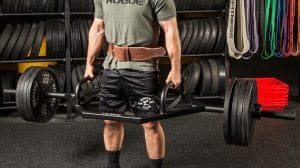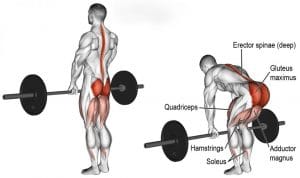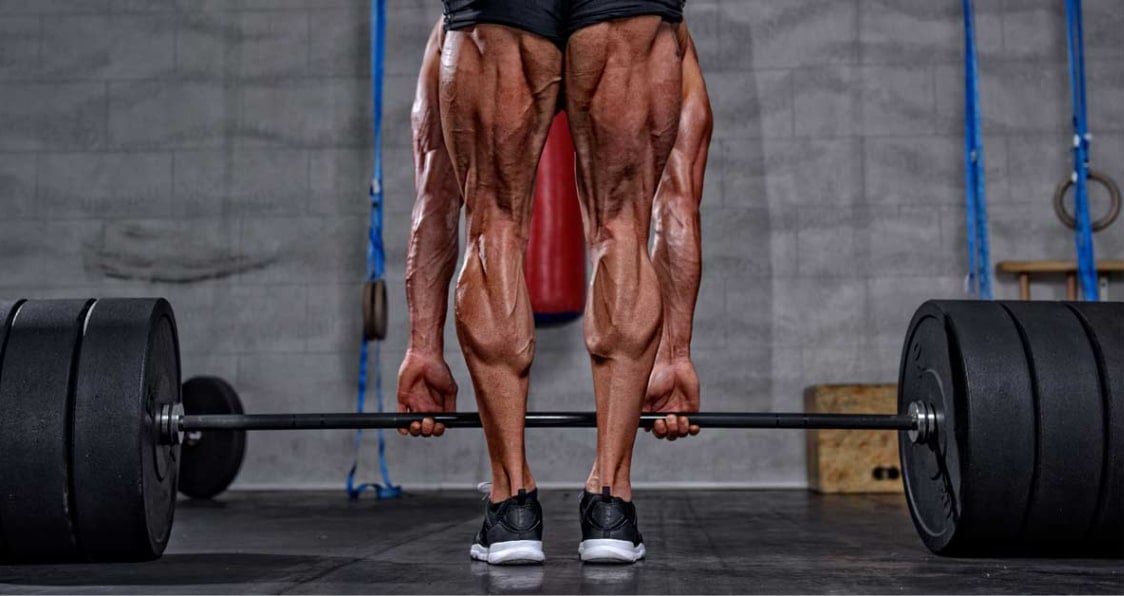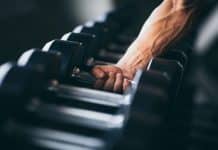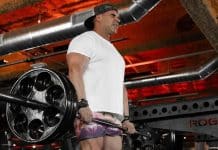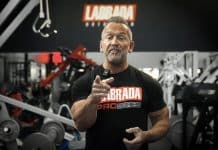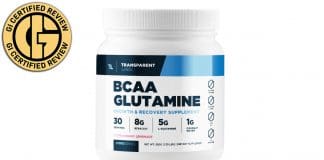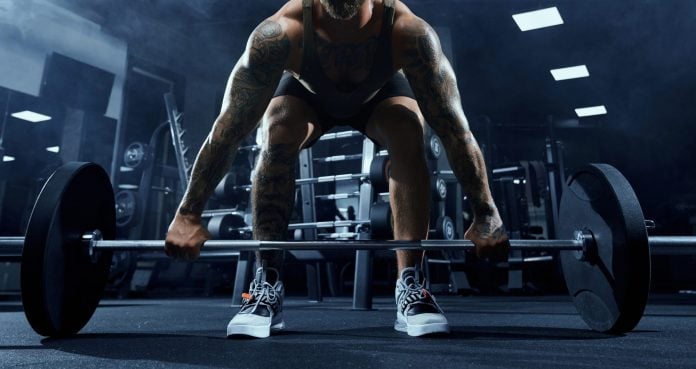
These tips and insights will make you a Romanian Deadlift master!
The Romanian deadlift (RDL) is at first glance just a conventional deadlift with a few small differences. Well, technically it is just that, but these minor changes are significant enough to make the exercise target different muscles than a regular conventional deadlift.
But, the RDL is also effective for building a phenomenal physique and increasing your full-body strength too.
What Exactly is an RDL?
The Romanian deadlift is a functional movement which will carry over to athletic performance as well, so the benefits reach far beyond just plain old aesthetics and power. But being a perfect posterior chain exercise, the RDL is a do-it-all movement.
So, we want you to get the best out of your workouts and that means familiarizing yourself with the Romanian Deadlift so that you can maximize your results.
That being said, here is some great important information about the Romanian deadlift that we think you can benefit from. But first, we’ll start with how the RDL got its actual name.
Origin of Romanian Deadlifts
The Romanian deadlift admittedly has a name that creates a sense of curiosity about its origins. So, to answer the question of where the name came from, the RDL was named after a very accomplished Romanian weightlifter named Nicolae “Nicu” Vlad.
Apparently, a few American weightlifters spotted Vlad doing his version of the “deadlift” and named the lift after him since he was from Romania.
But, the RDL is technically not a deadlift since it not lifted off the ground, which makes the name a bit confusing.
Muscles Involved
Like previously mentioned, the RDL works the entire posterior chain (Backside of the body) of muscles. But there are also muscles which receive a lot of stimulation due to their assistance in the exercise.
A study showed hamstring activation to be very high during the RDL and this is a main target muscle, which is why you see the RDL being utilized heavily by lifters on leg days. (1)
But, overall the rear muscles are worked pretty equally.
The muscles involved include:
- Back (Rhomboids, Latissimus Dorsi, Trapezius and Erector Spinae)
- Legs (Quadriceps, Hamstrings, and calves)
- Gluteus Maximus
- Core (Abdominals, Obliques)
- Hip flexors
- Biceps
- Forearms
Benefits
There are numerous benefits to doing the Romanian deadlift.
From muscle and strength building to functionality and overall performance… the RDL is an excellent movement.
If you play sports, you need a strong posterior chain plus hip extension/flexion for pretty much all athletic movements (Jumping, running, bending, etc). But, fitness competitors and even people rehabbing from injury can benefit from utilizing the RDL. (2)
Now, another benefit is that you can learn hip flexion and extension independent of spine flexion. (3)
RDL Variations
The beauty of weight training is that there is something for everyone to enjoy. Some people may not have the mobility to train with barbells, so dumbbells and even kettlebells can offer a great alternative. But, the Smith machine and even a trap bar can be very beneficial as an effective training tools for your RDLs, and all of them bring equal benefits to your progression.
Here are the popular variations of the RDL:
- Dumbbell Romanian deadlift
- Single-leg Romanian deadlift
- Smith machine Romanian Deadlift
- Trap bar Romanian deadlift
All of these variations have their own unique benefits.
Dumbbells – The dumbbell deadlift is a very effective variation for the RDL because it develops balance, stabilization, a freer range of motion, and motor control. (4) Former 4x Mr. Olympia winner, Jay Cutler, was a big believer in dumbbell RDLs.
Single-leg deadlift – This variation is ideal for unilateral (Affecting one side) development and being able to isolate each muscle is great for several reasons… (5)
Unilateral benefits:
- Correct muscle imbalances
- Increase core strength
- Improve Balance
- Rehabilitation
Smith machine deadlift – This variation is great for people who don’t quite have good balance or who prefer to only have to focus on moving the weight. There’s not much stabilization required and you can safely use heavy weights too.
Trap bar deadlift – The trap bar deadlift is very beneficial because it lessens the stress on your spine by allowing you to pull closer to your center of gravity and allows you to move through a more natural range of movement. (6, 7)
But, the grip placement is also different since it is similar to training with dumbbells.
Training Tips
Since the Romanian deadlift varies in certain aspects from the conventional deadlift, it’s important to know how to execute the movement.
So, here are some tips for your training days to ensure you get the results you’re looking for…
Form
Keep your knees slightly bent, but also keep your legs mostly straight, during the exercise and your back should be straight while slightly arched. Then, keep your shoulders back and down. Remember, this is more of a hamstring-focused exercise.
You want to keep the weight as close to your body as possible and positioning yourself correctly will ensure this.
The movement
You can start the RDL with the bar on the ground or on a power rack. But make sure the bar is set high on the rack so you can start closer to the top of the movement.
Now, the deadlift isn’t technically a “deadlift,” which implies you’re pulling the bar from off of the ground. And the movement involves no contact with the ground except for the initial lift-off.
On the concentric (Positive) phase of the movement, you want to push upward through your heels and mid foot. But then you want to thrust your hips forward halfway through the movement to complete the lift in an erect position.
The hips are doing a lot in the RDL and even more so than with conventional DL where the quads are more heavily involved.
Range of motion
This is where the Romanian deadlift really differs from the standard deadlift.
Instead of lowering the bar all the way down until it touches the floor, you’ll lower the bar to about mid-calf level with the RDL. This keeps constant tension on the posterior chain of muscles (Especially the hamstrings and glutes).
Then, you’ll come all of the way up until you’re erect as you would with a standard deadlift.
Sets/Reps
The Romanian deadlift is not much different than a conventional deadlift training structure. However, the RDL is not quite as taxing on the body, and therefore you can generally do a little more in terms of volume.
And of course, sets/reps schemes vary based on training experience. But, warming up and doing a pyramid up in weight is recommended to get the joints and nervous system conditioned for more intense sets with heavier weights.
Beginner – If you’re a beginner, it’s best to do about 3 sets with good form and light to moderate weight. This will help you stay injury-free and develop the best form possible. Reps should stay at around 10-15 until more advanced.
Intermediate – If you’re an intermediate lifter, go with 3-4 sets and train with more moderate to moderate/heavy resistance loads.
Intermediate lifters can train heavier and with lower rep ranges of 8-10 but it’s best to mix it up sometimes with higher reps.
Advanced – If you’re more advanced, then you likely know your body by now and can get away with more sets and more volume. So, 4 sets with heavier resistance loads should be completely appropriate for sufficient stimulus.
Advanced lifters have an advantage when it comes to training because they know their bodies very well. So, anywhere from 6 reps and up is perfectly fine, in combination in varying rep ranges.
RDL Exercise Steps
If you want to experience all that the Romanian deadlift has to offer, then you’re going to need to know how to do it effectively.
It’s not like a regular deadlift regarding the focus of the movement and like mentioned before, the differences are notable.
So, here’s a quick step by step guide…
- Start with the barbell on the floor or elevated on a power rack. If on a rack, start in a higher position at about mid-thigh level or even slightly higher.
- Grip the bar at a shoulder-width or slightly wider position.
- Arch your back and slightly bend your knees.
- If starting from the floor, stick your butt out and keep your upper legs slightly above parallel to the floor. Now, push through your heels and mid foot while extending the hips until you’re standing straight.
- If starting from the rack, bend your knees slightly and extend your hips upward to lift the weight off the bars until you’re standing straight.
- Slowly lower the bar to mid-calf level by focusing on hip flexion while keeping your back arched.
- Extend through your hips while keeping the pressure of the weight in your heels until you’re standing straight. Your shoulders should be down and back.
- Then, you can repeat this movement as desired for repetitions.
Sample Workout Routine:
Warm up with 2 sets of progressive RDL’s at about 30 and 60% of your one-rep max before doing your working sets.
Romanian deadlift
3 sets x 10-12 reps
(Rest 60 seconds in between sets)
Lying hamstring curls
2 x 10-12
(Rest 30-45 seconds in between sets)
Alternating lunges
3 sets x 10-12 reps
(Rest 45 seconds in between sets)
Leg press calf raises
3 sets x 15 reps
(Rest 30 seconds in between sets)
Romanian Deadlift Wrap Up
The Romanian deadlift is a must for overall posterior chain development. It’s also an excellent variation and/or alternative to the conventional deadlift depending on your training goals.
But, it’s important to learn and develop proper technique while implementing progressive resistance to experience maximum results.
Now, since there are several variations, feel free to experiment to find what works best for you. There’s no one best method of training when doing the Romanian deadlift as long as the movement stays the same.
…We hoped you enjoyed this useful information about the much popular Romanian Deadlift and now you have everything you need to make some serious gains!
For more news and updates, follow Generation Iron on Facebook, Twitter, and Instagram.
All images courtesy of Envato
References:
1– McAllister, Matt J.; Hammond, Kelley G.; Schilling, Brian K.; Ferreria, Lucas C.; Reed, Jacob P.; Weiss, Lawrence W. (2014-6). Muscle activation during various hamstring exercises. Journal of Strength and Conditioning Research. 28 (6): 1573–1580. doi:10.1519/JSC.0000000000000302. ISSN 1533-4287. PMID 24149748.
2– Deane, Russell S.; Chow, John W.; Tillman, Mark D.; Fournier, Kim A. (2005-8). Effects of hip flexor training on sprint, shuttle run, and vertical jump performance. Journal of Strength and Conditioning Research. 19 (3): 615–621. doi:10.1519/14974.1. ISSN 1064-8011. PMID 16095411
3–ACE – ProSource™: January 2016 – ACE Technique Series: Romanian Deadlift.
4–Free weights or machines? Choose what’s right for you
5–The Benefits of Unilateral Training
6–UCSB Science Line. scienceline.ucsb.edu.
7–Biomechanics of Safe Lifting. ergo.human.cornell.edu.
Header image courtesy of Envato Elements



